Vocal for local: NSG takes on invasive vilayati kikar, to regreen 5-km stretch of Manesar campus with local trees
In the past couple of years, the NSG has planted nearly 10 lakh saplings of local varieties on the hills using the trench pattern of plantation to ensure judicious use of water.
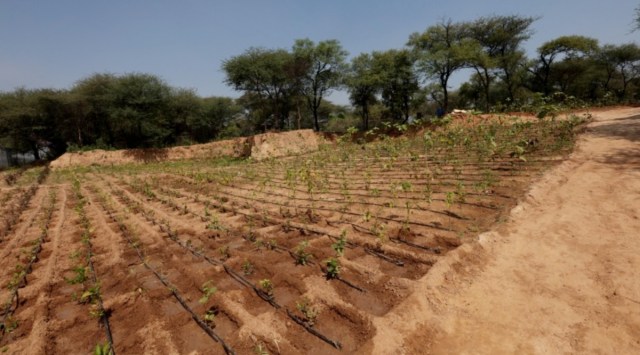 The Miyawaki plantation method has also been used at NSG's Manesar campus. (Express Photo by Gajendra Yadav)
The Miyawaki plantation method has also been used at NSG's Manesar campus. (Express Photo by Gajendra Yadav) The country’s elite counter terror force has declared a ‘war’ — on an invasive plant species.
In 1986, when the National Security Guard (NSG) was granted 1,600 acres abutting the Delhi-Ajmer highway in Manesar to build its campus, there were 98 functional borewells. At present, 63 of these have gone dry. The force has now decided to take on the vilayati kikar (Prosopis juliflora) populating its Aravali hills campus, after it was found to be responsible, among other reasons, for the depleting water table.
Native to Mexico, vilayati kikar was brought to Delhi by the British in the 1920s, when the national capital was being built.
The NSG has earmarked an area of 1,000 acres, spread over a 5-km stretch on campus, for the project that aims to regreen the Aravallis with local varieties of plants. More importantly, the force has begun cutting down kikar trees before planting the new saplings since the invasive species does not allow other plants to grow around it.
 The NSG has earmarked an area of 1,000 acres, spread over a 5-km stretch on campus, for the project that aims to regreen the Aravallis with local varieties of plants. (Express Photo by Gajendra Yadav)
The NSG has earmarked an area of 1,000 acres, spread over a 5-km stretch on campus, for the project that aims to regreen the Aravallis with local varieties of plants. (Express Photo by Gajendra Yadav)
Sources said past attempts at regreening the campus had failed for precisely this reason. Other reasons cited for this failed attempt include poor availability of water, inadequate retention of water due to the nature of the terrain and the nilgai, the largest Asian antelope, eating away saplings of local tree varieties.
In the past couple of years, the NSG has planted nearly 10 lakh saplings of local varieties on the hills using the trench pattern of plantation to ensure judicious use of water. This pattern of plantation involves plots that are ploughed to create trench-like rows for sowing of saplings. These trenches help channel rainwater through the plantation, keeping it irrigated.
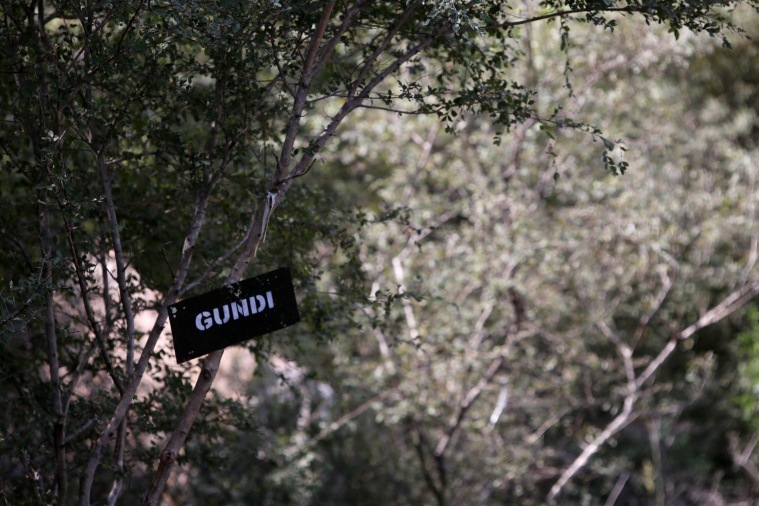 In the past couple of years, the NSG has planted nearly 10 lakh saplings of local varieties on the hills using the trench pattern of plantation to ensure judicious use of water.
In the past couple of years, the NSG has planted nearly 10 lakh saplings of local varieties on the hills using the trench pattern of plantation to ensure judicious use of water.
A site visit by The Indian Express revealed that a significantly large number of these saplings had survived. NSG commandos were seen pruning and cutting down existing kikar trees before fresh plantation.
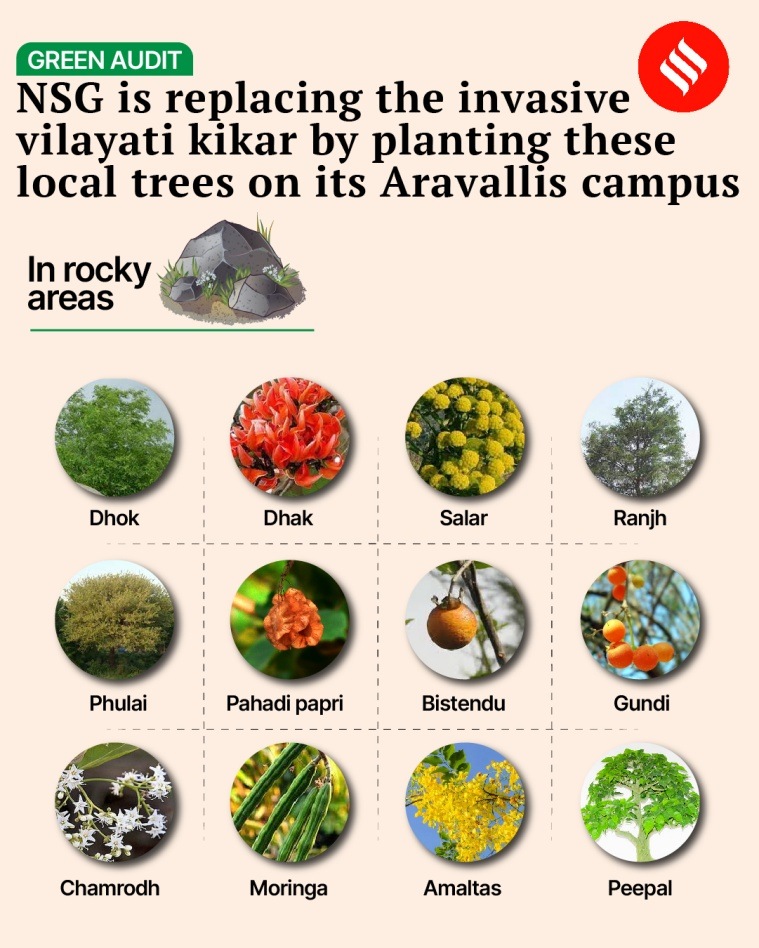


A Japanese plantation method and ambitious targets
For the section of the campus that lies on the foothills of the Aravallis, the force has hired experts in Miyawaki plantation. The Japanese method relies on overcrowding the plantation area with saplings of different varieties to create competition that propels faster growth.
“The Union Home Minister has set ambitious annual plantation targets for all Central Armed Police Forces (CAPFs). We felt that these targets could be incorporated into a larger rewilding plan for the Manesar campus of the NSG. So a five-year plan, commencing from 2021-22, was designed to prune vilayati kikar on around 700 acres of the Aravallis (campus) and to plant local species (instead). The NSG also intends to develop forest patches in and around 300 acres of the area in the non-Aravallis stretch of the Manesar campus,” NSG Director General M A Ganapathy said, adding that his aim was to make the campus “carbon neutral”.
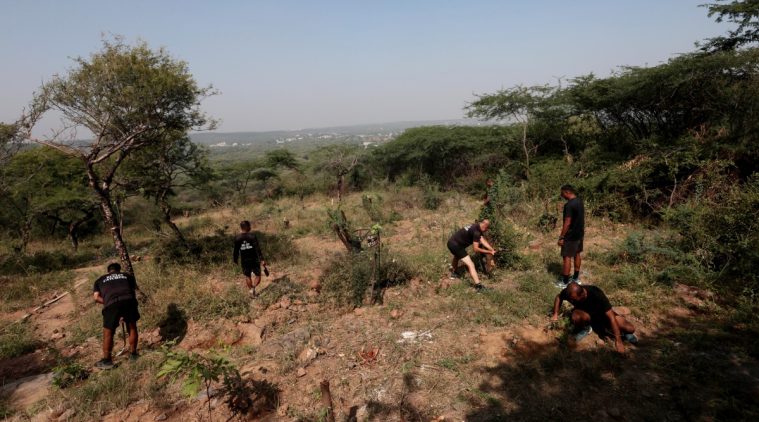 NSG commandos cutting down vilayati kikar trees to make way for local saplings. (Express Photo by Gajendra Yadav)
NSG commandos cutting down vilayati kikar trees to make way for local saplings. (Express Photo by Gajendra Yadav)
Since the Aravali hills are naturally arid with poor availability of water, barring the rainy season, the force is also dredging the range’s troughs that have been selected geospatially to trap rainwater and create water bodies that will not only recharge the water table but also make water available around the year. One such water body has already been created by trapping water discharged from water treatment plants on campus.
“Our water table has been going down constantly. Apart from massive urban development around the campus over the past few years, among the reasons (for this depletion of the water table) was also the ubiquitous vilayati kikar. So a decision was taken to populate the hills with native varieties as well,” said NSG Group Commander Jagdish Maithani, who is leading the project.

However, their initial efforts came a cropper. “We had planted around 1 lakh trees in 2021, but only 3 per cent survived,” said Maithani.
The force then roped in the Haryana forest department, environmental experts and NGOs, who pointed out that as long as kikar trees were around, the chances of survival of other species would remain slim.
 Vilayati kikar is an invasive species that can quickly colonise an entire area. (Express Photo by Gajendra Yadav)
Vilayati kikar is an invasive species that can quickly colonise an entire area. (Express Photo by Gajendra Yadav)
“We decided to cut kikar trees and to keep pruning them until the new plants grew tall enough to survive the tough conditions. Pruned branches of the trees were used to make fences to keep the nilgai from entering the plantation area. The current survival rate of the saplings is 90 per cent,” Maithani said.
Environmentalist Vijay Dhasmana, who was consulted by the NSG for the project, said the vilayati kikar is an invasive species that can quickly colonise an entire area, and its roots and leaves secrete certain alkaloids that prevent the growth of other species. Since herbivores do not prefer it either, it has a negative impact on the biodiversity of an area. “Also, its canopy blocks the sun, preventing the growth of understorey. These trees must be pruned so that other plants get a chance to establish themselves. And then the kikar can be removed,” he said.
Conservationist Sunil Harsana, who is responsible for the afforestation of Delhi’s Mangar Bani forest and was also consulted by the NSG, said the kikar roots spread across underneath the turf and suck all the moisture in the soil. “Also, since they shed leaves for a very short period, they need water all year. This can lead to the depletion of the water table,” he said.
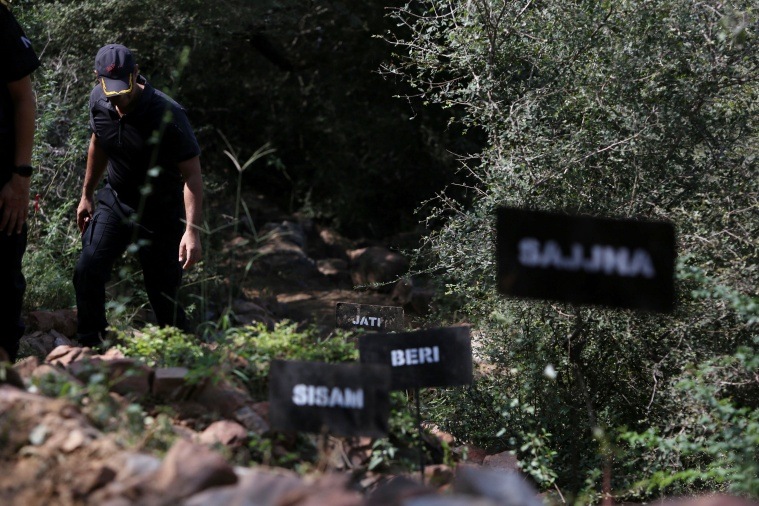 In the past couple of years, the NSG has planted nearly 10 lakh saplings of local varieties on the hills using the trench pattern of plantation to ensure judicious use of water. (Express Photo by Gajendra Yadav)
In the past couple of years, the NSG has planted nearly 10 lakh saplings of local varieties on the hills using the trench pattern of plantation to ensure judicious use of water. (Express Photo by Gajendra Yadav)
Dhasmana, however, said there were no conclusive studies of kikar’s impact on the water table.
A solar pump and nilgai menace
According to the NSG, local tree varieties being used for the drive are being planted in 50-100 metres plots surrounded by fences and maintained by commandos. In rocky areas, trees like dhok, dhak, salar, ranjh, phulai, pahadi papri, bistendu, gundi, chamrodh, moringa, amaltas and peepal will be planted. Valley areas will see native varieties such as barna, kala siris, kaim, amaltas, moringa and neem. In the sandy plains, khejri, pillu, jaal, roheda, amla, kanker and ashok will be planted. Besides karonda, gangeti and arna as shrubs for undergrowth, the saplings will be interspersed with fruit trees like chikoo, mango, jamun, guava and bel, the NSG said.
The force has tied up with NGOs Bhumi and Catch for the implementation of the project. To ensure water supply, the force has built a water tank over the hill where water is lifted from the ground using a solar pump. Each plot also has a pit to collect rainwater. In plots that are remote, only varieties that are not eaten by nilgais have been planted.
A forest department official said the department has been providing saplings to the force.
The official added, “The NSG has a huge target (for its plantation drive). If it succeeds, the entire landscape (of the area) will change.”







